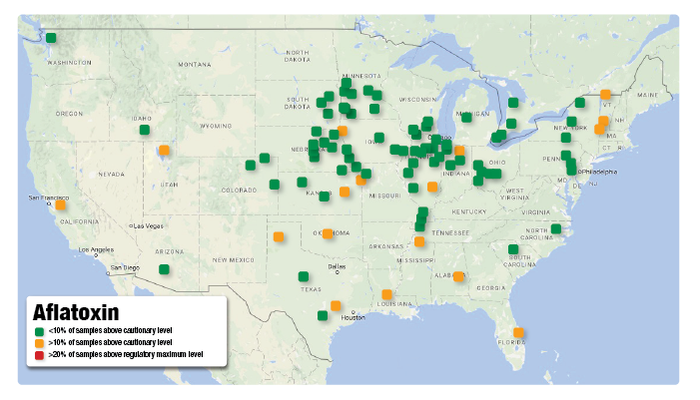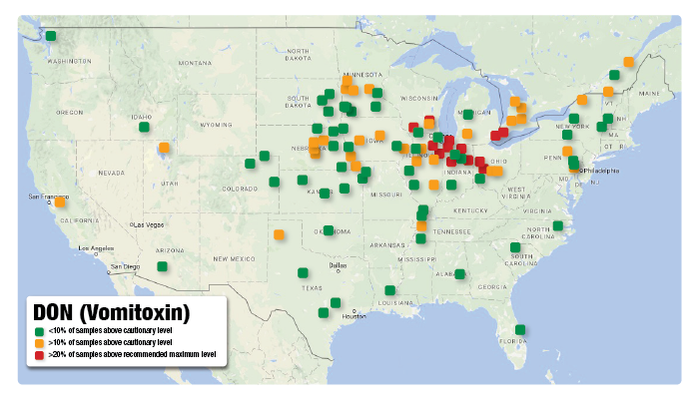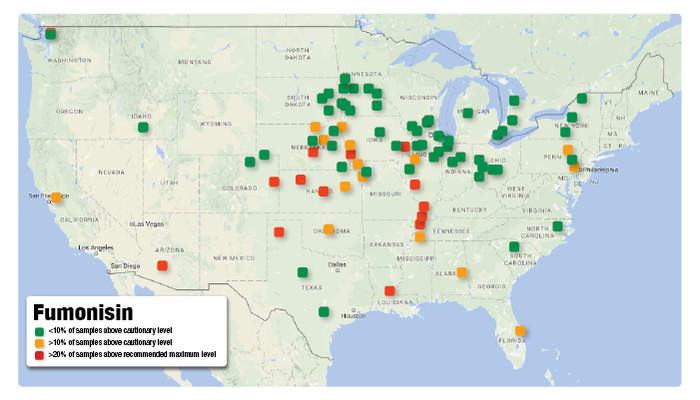Mycotoxin results indicate this year to be the most challenged in the last 5 years
December 15, 2016

Sponsored Content
Mycotoxins have an estimated $5 billion (USD) impact on the U.S. and Canadian food animal industries annually. Recent trends in mycotoxin results have indicated this year’s crops may be some of the most challenged in the last five years. At Cargill’s laboratory in Elk River, Minn., we have seen indications of widespread deoxynivalenol and fumonisin this year. Meaningful incidences of aflatoxin and zearalenone in some regions are also noteworthy.
Mycotoxins are difficult to sample and measure, so understanding the extent of mycotoxin challenges in feed ingredient sources and effective mitigation tactics for specific mycotoxins is imperative for the commercial success of affected animal production operations.
A good defense is your best offense! The first line of defense against mycotoxins should be using all practical efforts to reduce animal exposure to mycotoxins.
First line of defense
Use practical efforts to reduce animal exposure to mycotoxins by minimizing usage of suspect ingredients in diets for young pigs and sows. Seek available mycotoxin surveys of your area to understand general mycotoxin risks in regional and local grain and byproduct supplies and ingredients. These reports can provide a guide to understand which toxins may be a risk for your enterprise.
Further mitigation tactics should include the following steps.
Install a pre-unloading, quick-test procedure such as ROSA by Charm Sciences Inc. or comparable certified test kits, with effective management responses to elevated results, such as rejection or segregation of suspect materials
Since mycotoxin levels generally concentrate in grain byproducts (from which a lot of the starch is removed for food or industrial purposes), monitor supplies carefully with testing and reduce or eliminate byproducts suspect for concentrated mycotoxins
If available, use alternative grain sources (such as sorghum or wheat) that may have lower mycotoxin contamination, but test these sources as well
Plan for multiple mycotoxin types
If you detect one mycotoxin, it is common to have others; fumonisin with aflatoxin, and zearalenone with DON are common combinations
Mycotoxin effects are generally additive and even low levels of multiple toxins can reduce the function of the immune system
Realize the natural distribution of mycotoxins is not uniform, originating from localized growth of molds in the field or in storage
Sample from multiple locations for representative testing
Understand it is common to see mycotoxin symptoms in only some animals or pens, while others may not be as severely affected or may show no symptoms
The most common mycotoxins are aflatoxin, deoxynivalenol (also known as DON, vomitoxin), zearalenone and fumonisin. With wet harvest conditions in some parts of the United States in 2016, we are seeing an increasing number of ingredient samples with high levels of DON. There have been a number of incidences of zearalenone in these affected areas, as well. Fumonisin and aflatoxin levels are higher in the southern half of the U.S., especially where drought or heat stress has occurred at key points in the growing cycle. When determining mycotoxin testing and mitigation plans, watch for key symptoms associated with each of these mycotoxins.
Aflatoxin
Aflatoxin is a highly toxic mycotoxin that decreases performance and overall animal well-being. While avoiding the use of feed materials with aflatoxin levels above 20 parts per billion for pigs and sows and 100 ppb for finishing pigs is legally required, even low levels of aflatoxin can enhance the impact of other mycotoxins.
Symptoms of aflatoxin consumption include:
Reduced feed intake
Depressed growth rate
Reduced feed efficiency
Reduced milk production by sows (thus reducing litter performance)
Increased sickness due to suppressed immune function
Jaundice due to liver damage
Poor reproductive performance
At high levels (>1,000 ppb), acute signs include slab-sided pigs, depression, difficulty walking and death.

Deoxynivalenol
Deoxynivalenol is a relatively common mycotoxin, especially in the northern half of the U.S. and in Canada.
Symptoms of DON consumption include:
Reduced feed intake
Reduced weight gain
Feed refusal (> 5 ppm)
Weight loss and vomiting (> 10 ppm)
Increased incidence of stillborn piglets in gilts
Reduced feed intake, weight loss and a tendency for increased weaning-to-estrus interval in sows
Chronic exposure to DON can produce ulcers on mucous membranes and diarrhea

Zearalenone
Also known as the reproductive mycotoxin, zearalenone and related compounds are most harmful for the breeding herd. Their estrogenic effects produce a range of changes to the reproductive tract that can disrupt reproductive performance. When zearalenone risk is known, it is advisable to monitor grain and grain byproducts being used in sow and boar diets, and to eliminate any known contaminated ingredients from the diets of reproducing animals. Zearalenone is often found in conjunction with DON and/or Gibberella ear rot in corn.
Symptoms of Zearalenone consumption include:
Vulva reddening and swelling in pre-pubertal gilts
Vaginal and rectal prolapses, abortions and stillbirths with first parity and multiparous sows
Irregular estrous cycles, missed cycles and reduced litter sizes
Immune system suppression in growing animals
Atrophy of the testes, enlarged mammary tissue and decreased fertility in boars
If higher concentrations are fed during the first two weeks of the post-mating period, embryo development ceases, and the sow will appear to never have been bred. Return-to-estrus time may be prolonged by many weeks.
Fumonisin
Fumonisin can be found in corn-producing areas throughout the United States, but is most common in the southern half of the U.S. Fumonisin is relatively low in toxicity for swine, requiring multiple parts per million before causing an effect. True fumonisin poisoning usually presents as “sudden death” in growing pigs with good body condition, but poisoning is only likely to occur when the diet contains over 100 ppm of fumonisin. Fumonisin seems to be more problematic in combination with other toxins, especially aflatoxin.
Symptoms of fumonisin consumption include:
Reduced appetite with reduced growth
Pulmonary edema, or filling of the lungs with fluid, which can be confused with pneumonia from other causes
Reduced nutrient absorption and increased disease susceptibility from the effects of the toxin on the gut lining
Overall weakening of the immune system, allowing for higher disease incidence or morbidity with prolonged exposure

Managing mycotoxin risks through nutrition
Understanding mycotoxin risks by following regional survey results, monitoring ingredients, managing suspect ingredients and employing mitigation tactics is essential for productive and profitable operations. Working with your nutrition team to determine the best measures for managing mycotoxins will be key when feeding crops grown in 2016 to livestock. Assistance can include formulation and nutrition solutions. PROMOTE additives are part of the nutrition solutions provided by Cargill, Provimi and Citura.
PROMOTE is a comprehensive line of feed additives and unique services serving the livestock and poultry industries. Contact your Cargill, Provimi or Citura salesperson for more information on PROMOTE additives or call our PROMOTE Customer Service representatives at 866-202-9889.
Don Giesting
Promote Additive Leader
Cargill Premix and Nutrition
C: 651-236-0418
O: 952-984-0468
About the Author(s)
You May Also Like



